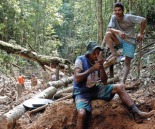Inhabitants
The Congo's rainforests are full of life, and not only animals. Humans have been living in the Congo rainforest for an estimated 20,000 years, and are each part of one of the 250 separate ethnic groups that live there.
The change from unrestrained anarchy to an organised government has not resulted in a change in the indigenous people of the Congo's lives, showing that these forest-dwellers live in their own world, isolated from the rest of us.
All of the inhabitants are vulnerable to the logging (deforestation) of the rainforest, mainly because trees are linked to one of the main parts of rainforest dwellers' diet; animals. The loss of trees leads to less habitats for animals, and eventually the extinction of either one or many species, severely impacting upon the lives of thousands of people.
Natives

The first of two types of human inhabitants are the pygmies, who grow to an average height under 150cm (4 feet 11 inches), and are hunter-gatherers who never strain the rainforest's resources, moving around within their tribal area so as to not completely deplete the food available there. They also have a very deep relationship with the Bantu farmers, who have also inhabited the Congo rainforest for thousands of years. Native pygmies have recently been evicted from some rainforest areas in order to turn the area into a national park, adding to the challenges that they already face. (For more information on African pygmies, click here.)
Also inhabiting the Democratic Republic of Congo's rainforests are the Bantu farmers, who are vital to the pygmies' survival, providing them with starch-filled products as well as processed food items in exchange for forest products such as edible plants and meat. These farmers are very conservative, only using techniques that have been proven to sustain the rainforest while still producing a good amount of produce. Some of these techniques are clearing forest for timber, and then reforesting the area, as well as rotating the areas that they use at any one time, similar to the pygmie hunter-gatherers' technique.
Non-Natives

Apart from the pygmies and Bantu farmers, there are others who also utilize the rainforest, albeit in a much less sustainable way than the natives.
Loggers are by far the most common, with hundreds of thousands of trees being cut down each year in order to cater for the global demand for timber from countries such as America and China. Over 40 million inhabitants of the Democratic Republic of Congo are dependant on the Congo's rainforests, and hardly any benefit from logging (statistics from Greenpeace). Another problem related to logging is the construction of roads through the rainforest, allowing both loggers and hunters easier access to the inner rainforest, where they can wreak havok.
Hunters are another problem, especially with the numbers of native animals such as the lowland gorilla dwindling to extremely low levels. This is compounded by the fact that roads are being built right through the rainforest, allowing hunters to access animals' habitats easily.
